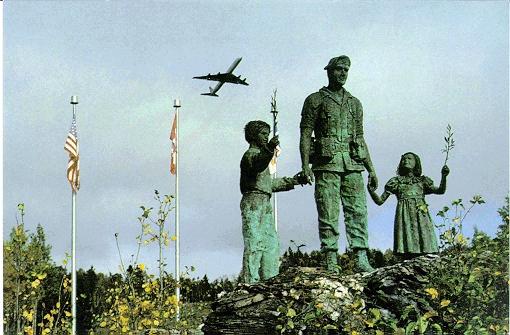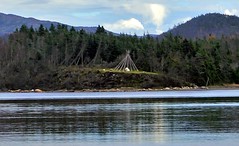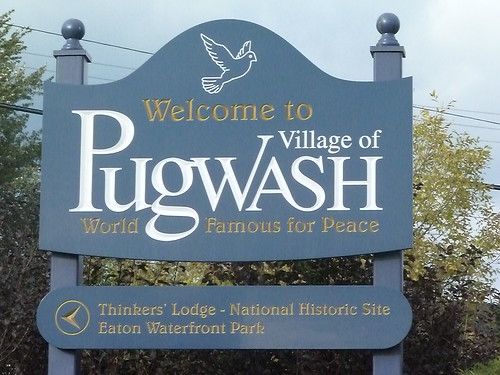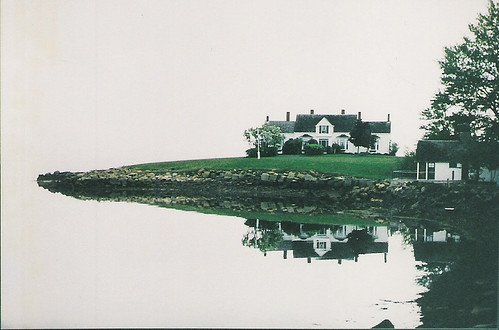

Peace Monuments in Canada
(excluding
British Columbia,
Ontario
& Québec)N.B.: Canada has 10 provinces and 3 territories. All 13 are listed below. The peace monumetns of 3 provinces are shown on separate web pages but with links on this page.
Click here for British Columbia. | Click here for Ontario (including Ottawa). | Click here for Québec. | Click here for US/Canadian friendship monuments.
Click here for one peace monument in each province and territory. | Click here for Inuksuit. | Click here for notable peacemakers in Canada.
Right click image to enlarge.

July 26, 1936 - Statue of Peace, Canadian National Vimy Memorial, Vimy (France). Uppermost sculpture on the memorial. "At the front of the monument [is] a woman, cloaked and hooded, facing eastward toward the new day. Her eyes are cast down, & her chin is resting on her hand. Below her is a tomb, draped in laurel branches & bearing a helmet. This saddened figure represents Canada - a young nation mourning her fallen sons. This figure was carved from a single, 30-tonne block of stone - the largest piece in the monument. Turning from this figure to look up at the pylons, you will see at the highest points, Justice and Peace [and Hope?]. Arranged below them are other figures representing Truth, Knowledge, Gallantry and Sympathy. Around these figures are shields of Canada, Britain and France." /// Red circle shows enlargement of new Canadian $20 bill. Click here for "'Three topless women & the Twin Towers: Canadians baffled by picture of WW-I memorial on their new $20 dollar bill. Banknote shows the Vimy Memorial - a statue in France representing the bravery and sacrifice of Canadian soldiers in the First World War. Concern from focus groups during 5-year consultation over design."


M
A
R
K
E
R
August 4, 1957 - "Unfortified Bountry" Monument, Mile 1223, International Border, (US & Canada). One of about 30 such monuments placed by Kiwanis International over a number of years. Inscription: "This unfortified boundary line between the Dominion of Canada and the United States of America should quicken the remembrance of the more than a century old friendship between these countries, a lesson of peace to all nations. Erected August 4 1957, Kiwanis International."
Alberta



C
A
I
R
N
1927 - Peace Hills Cairn, Highway 2A, Hobbema, near Wetaskiwin, Alberta (Canada). Commemorates the 1867 peace treaty with the Cree Indians. Wetaskiwin means "Peace Hills." Entry #1222 in the "Peace Movement Directory" by James Richard Bennett (2001).
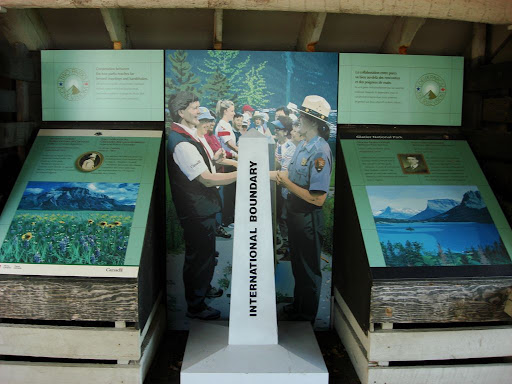



June 18, 1932 - Waterton-Glacier International Peace Park, Alberta (Canada) & Montana (USA). "Oldest international peace park [sic]." Established on the initiative of Rotary International. Designated a UNESCO World Heritage Site in 1995. Upper image is cover of Saturday Evening Post for August 5, 1961, showing a happy family on the international border. Click here for Wikipedia article. Entry #1210 in the "Peace Movement Directory" by James Richard Bennett (2001).





2007 - Peace Exhibit, Goat Haunt Ranger Station, Glacier National Park (USA). At south end of Upper Waterton Lake. No road access! "Visitors can view a new International Peace Park exhibit at Goat Haunt. The exhibits explore the history of the Peace Park - the world's first - as well as the meanings of peace in the world." ["Celebrating 75 Years of Peace & Friendship," National Park Service, July 19, 2007].



2007? - Peace Exhibit, Waterton Lakes National Park (Canada). At north end of Upper Waterton Lake. Peace Exhibit exists according to Nigel & Antonia Young.


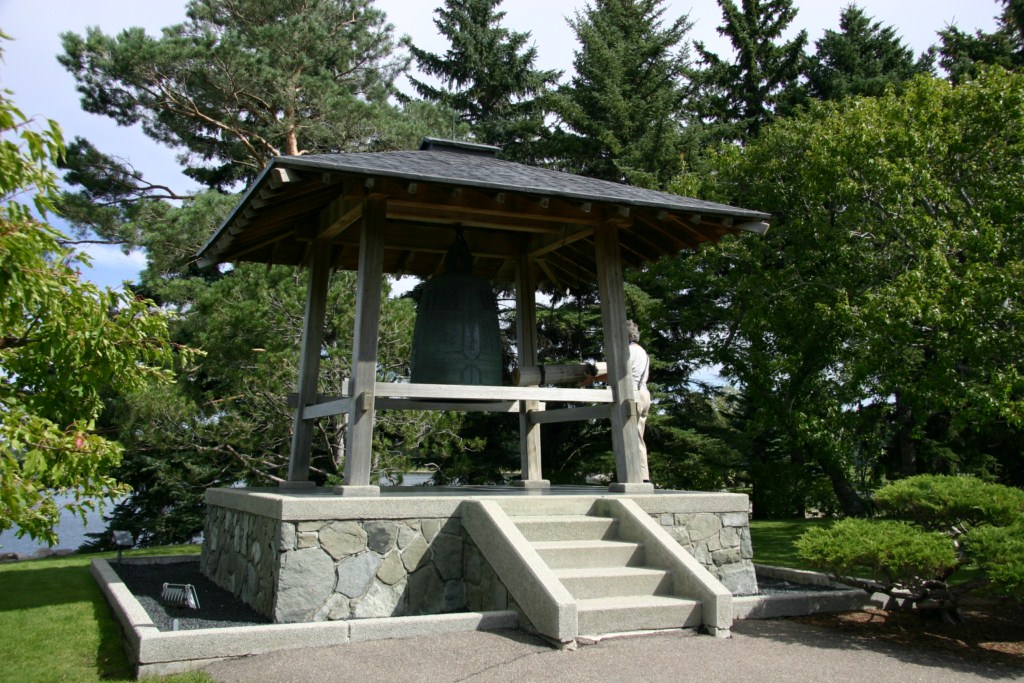

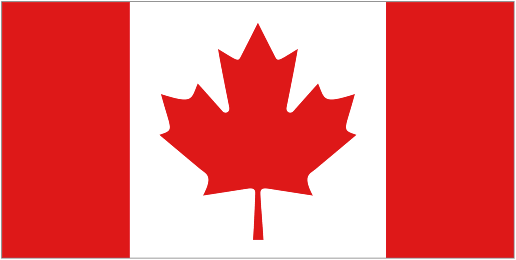
1967 - Friendship Bell, Nikka Yuko Japanese Garden, Lethbridge, Alberta (Canada). "Established during Canada's Centennial in 1967, Nikka Yuko was built to recognize contributions made by citizens of Japanese ancestry to the multi-cultural community of Lethbridge & as a symbol of international friendship. Its name was created from the Japanese words Ni (from Nihon meaning Japan), ka from Kanada or Canada, & Yuko, which translates as 'friendship' to mean 'Japan-Canada friendship'... The bronze Friendship Bell, which hangs in the bell tower, was commissioned specifically for Nikka Yuko & cast in Kyoto [by Iwasawa?]. The bell's deep tones ring a friendship call to all visitors."
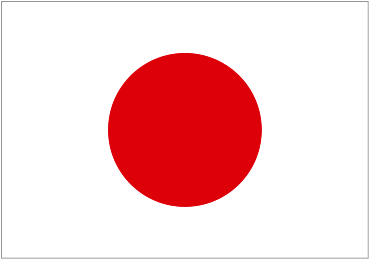

G
R
O
V
E
August 15, 1992 - Peace Grove, West Eau Claire, Calgary, Alberta (Canada). Twelve elm trees celebrating Canada's 125th birthday and its international peacekeeping role. Entry #1218 in the "Peace Movement Directory" by James Richard Bennett (2001).
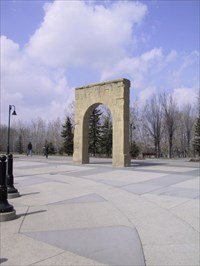
A
R
C
H
+
P
A
R
K
1992 - Memorial Arch, Peace Park, Eau Claire Promenade, Prince's Island Park, 2 Avenue & 8 Street SW, Calgary, Alberta (Canada). "In 1992 the park was dedicated as part of a Canada 125 project to commemorate Canada's peacekeepers (one of 250 peace parks that opened throughout Canada that year). Memorial Arch acts as a memorial to the soldiers who died in World War 1, 2 and the Korean War. Originally, the Arch was part of the Strathcona Building built during WW1. The Arch was salvaged when the building was demolished and spent several years in City storage before it was erected at the Bridgeland LRT station in 1985. It was dismantled block by block and reconstructed in Peace Park in 1992." Twelve elm trees arranged in a circle, an ancient Bosco Sacro design that represents peace, were also planted in the park.

P
A
R
K

Date? - Rotary Peace Park, Vegreville, Alberta (Canada). Near the Ukrainian pysanka (giant Easter egg).

M
A
R
K
E
R
June 29, 1995 - "Toil & Peaceful Life" markers, Highway 3, Cowley, Alberta (Canada). Commemorate the centennial of the destuction of weapons by Doukhobors in Transcaucasia (Russia). Entry #1220 in the "Peace Movement Directory" by James Richard Bennett (2001).

G
U
N
S
2001 - The Gun Sculpture, Edmonton, Alberta (Canada). "Artists Wallis Kendal & Sandra Bromley took 7,000 guns of all kinds, from small handguns to rocket launchers, and fused them into a monolith called The Gun Sculpture. The purpose of the piece is to encourage discussions about violence. The artwork has toured all over, most recently as an installation at the United Nations complex in Vienna (Austria) where it was part of The Art of Peacekeeping exhibit last summer." /// "The artists consider their full project to consist of three elements: a large cube made from weapons, a series of photographs & text on victims of violence, & a blackboard for visitor comments. Obviously, such a diverse & diffuse presentation of content is not a ‘sculpture,’ per se, but rather is an installation."
British Columbia
Click here for Paciic webpage.
Manitoba
G
A
R
D
E
N
July 14, 1932 - International Peace Garden, Dunseith, North Dakota (USA) and Boissevain, Manitoba (Canada). "2,339 acre botanical garden on the world’s longest unfortified border." Includes 20-foot concrete Peace Tower, Peace Chapel, and 911 Memorial. Click here for Wikipedia article. Entry #1209 in the "Peace Movement Directory" by James Richard Bennett (2001).


C O L L E G E 
1967 - Global College, University of Winnipeg, 515 Portage Avenue, Winnipeg, Manitoba (Canada).

C O L L E G E 
1970's - Menno Simons College (MSC), Canadian Mennonite University (CMU), 520 Portage Avenue, Winnipeg, Manitoba (Canada).

B
E
L
L
S
1976 - Carilion Bell Tower, International Peace Garden, Dunseith, North Dakota (USA), and Boissevain, Manitoba (Canada). Construted by North Dakota veterans as a US Bicentennial project. Contains bells made in England in 1932 but not donated to the Peace Garden until 1969.

T
O
W
E
R
S
1982 - Peace Towers, International Peace Garden, Dunseith, North Dakota (USA) and Boissevain, Manitoba (Canada). 120 foot (36.6 meters) tall with four columns representing people from the four corners of the world coming together to form two similar but distinct nations with a common base of democracy and beliefs.

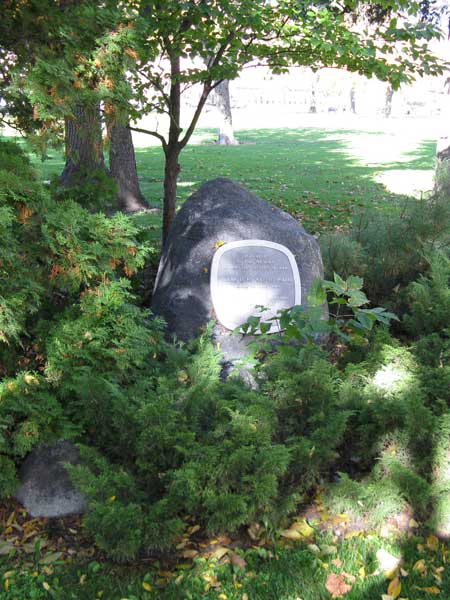

M O N U M E N T 
August 6, 1985 - Victims of War Monument, Provincial Legislative Building, Southwest Grounds, Assiniboine Avenue, Winnipeg, Manitoba (Canada). "Granite boulder. In honour of the victims of war, this commeorative cairn marks the 40th anniversary of the Hiroshima nuclear bombing. The plaque & adjacent peace garden represent the need & desire for peace among all people." Entry #1261 in the "Peace Movement Directory" by James Richard Bennett (2001).


C A R V I N G 
1991 - "Anishinaabe" (Statue #67), across from Caboose Tourist Booth (west side of park), Winnipeg Beach, Manitoba (Canada). Height 35 feet. Carved by Hungarian-American sculptor Peter Wolf Toth whose "Trail of the Whispering Giants" has at least one carved wood Indian statue in every US state & some (but not all) Canadian provinces.

S T A T U E 
2010 - Statue of Mahatma Gandhi, Canadian Museum of Human Rights, Winnipeg, Manitoba (Canada). "The Government of India presented the statue as a gift to the Friends of CMHR in 2004. The sculpture was created by renowned sculptor Ram Vanji Sutor & has been on display at the Fork Market Building for the past six years..."



E
V
E
N
T
October 1-2, 2010 - 8th Annual Conference, Peace & Justice Studies Association (PJSA), Winnipeg, Manitoba (Canada). With Canadian Mennonite University's Menno Simons College & University of Winnipeg's Global College. Theme: "Building Bridges, Crossing Borders: Gender, Identity, and Security in the Search for Peace."


September 10, 2011 - Manitoba Conscientious Objector Memorial, Bethel Heritage Park, Winkler, Manitoba (Canada). "The Wall of Remembrance, a peace memorial & teaching aid recognizing all 3,021 Manitoba conscientious objectors during World War II,... is part of a concerted community effort, supported by donations, to do the right thing with a hectare (acre) of land in the middle of town. When their old Bethel Hospital was demolished 5 years ago, the city council heard proposals, from which emerged an educational park showcasing their diverse community. The result was an outdoor classroom along a walking path with: An entrance gate similar to Mennonite villages in Ukraine, storyboards depicting Winkler's history, war memorial for veterans, peace memorial to conscientious objectors (CO's) & garden features (fountain, gazebo, flowers). Though the majority (55% in 2001) are of Mennonite descent, with 10 of 19 churches being Mennonite, other denominations of Germans from Russia & Jews have co-existed for generations."

September 9, 2012 - Cairn to Conscientious Objectors, 10th Avenue NE, Altona, Manitoba (Canada). "A memorial to the many thousands of people who chose alternative service instead of military service during wartime. 'This community was founded by people who came here [from Ukraine] because they were conscientious objectors,' said Bernie Loeppky, a spokesman for the local group that spearheaded the project. 'A marker like this is much more than a memory, it is also a teaching tool. From this marker we expect people will ask questions as to why people chose to be a CO.' // In Canada, conscientious objectors were often assigned to an alternative civilian service during the war as a substitute for conscription or military service. Loeppky says those who chose alternative service made contributions that have benefited the country. // A fairly large crowd turned out for the ceremony on Sunday afternoon. The monument has a bronze plaque attached to a stone that stands about 8 feet tall. Loeppky says conscientious objectors date back to the early Church. // Loeppky says it has been a long process in getting to this point. 'Originally, many of the COs that were part of this did not want to be recognized. However, after some time, we managed to generate some enthusiasm and interest. We did one in Winkler [qv, 40 km West of Altona] earlier, and other memorials are being planned in locations throughout Canada.'" /// Information courtesy of Conrad Stoesz, Archivist, Mennonite Heritage Centre, Winnipeg, 13Nov2013.


M
U
S
E
U
M
September 20, 2014. - Canadian Museum for Human Rights (CMHR), Winnipeg, Manitoba (Canada). "First national museum outside of the Canadian Capital." /// "Following the experiences of Bilbao and Valencia, this Canadian city hopes to draw tourists to an architecturally significant project." Designed by American architect Antoine Predock. "Perhaps the most transformational project before our nation today. As the largest centre of its kind anywhere, it has the potential to be one of Canada’s most significant contributions to promoting human rights here and around the world."
New Brunswick
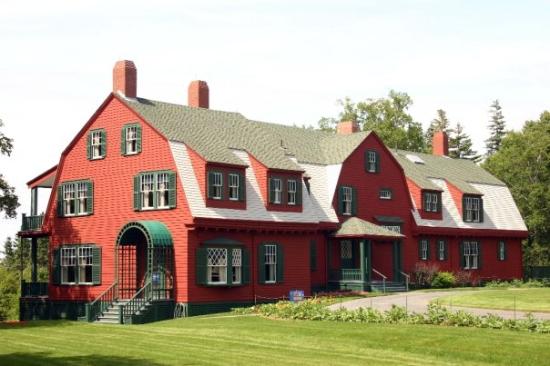
P
A
R
K
August 20, 1964 - Roosevelt Campobello International Park, Campobello Island, New Brunswick (Canada). "From 1883 onward, the Roosevelt family of Hyde Park, New York (USA), made Campobello Island their summer home. Their son, Franklin D. Roosevelt, would spend his summers on Campobello from the age of one until, as an adult, he acquired a larger property - a 34-room 'cottage' - which he would use as a summer retreat until 1939. It was here that Franklin D. Roosevelt, Jr., was born in August 1914." This is where FDR suddenly contracted polio in August 1921 at age 39. Image shows the Roosevelt Cottage in what became the international park on August 20, 1964. NB: Only bridge to Campobello Island is from Maine (USA). The l,l58 hectare (2,800 acre) park also contains "Sunsweep," stone monument by sculptor David Barr (qv). Entry #1264 in the "Peace Movement Directory" by James Richard Bennett (2001).



S
T
O
N
E
1985 - East End of Arc, SunSweep, Roosevelt Campobello International Park, Weshpool, New Brunswick (Canada). In Canada but accesible only by road from the USA. SunSweep is three stone monuments by sculptor David Barr spanning 2,778 miles of the international border between the USA & Canada. Entry #1265 in the "Peace Movement Directory" by James Richard Bennett (2001).



P
A
R
K
November 11, 1992 - Caseley Park, off of Buckingham on Bradford, Riverview, New Brunswick (Canada). " Dedicated to peace as part of the Peace Parks Across Canada project during Canada's 125th birthday celebrations. Riverview joined some 400 other communities in planting Peace Groves of 12 trees, symbolizing the ten provinces and (at the time) two territories. Near the park entrance stand the 12 trees which comprise the Peace Grove." "There is a monument in the centre of a circle of trees in remembrance of our 14 sisters who were killed in Montreal on December 6, 1989. It is placed there to honour and grieve all abused women. Also in Caseley Park there is a monument placed in dedication of the memory of the Canadian Merchant Navy."
Newfoundland & Laborador
S
T
A
T
U
E
June 24, 1990 - "Silent Witness" Memorial, Gander Lake, Gander, Newfoundland (Canada). Memorizes 256 victims who died December 12, 1985, when Arrow Air Flight 1285 crashed while transporting Multinational Force Observers (MFO's) from the Sinai via Cairo to Ft. Campbell, Kentucky (USA). Depicts an unarmed soldier holding the hands of two civilian children, each with an olive branch of peace. Plaque says, "Blessed are the peacemakers (Matthew 5:9). PdIns Sculpted by Stephen Sheilds of Hopkinsville, Kentucky (USA).

![]()
G
A
R
D
E
N
1992 - Mount Pearl Bahai'i Peace Garden, Mount Pearl, Newfoundland (Canada). "The Bahá'í community was formally established in this province in 1949 when three Bahá'ís from mainland Canada settled in St. John's. As the local Bahá'í communities grew large enough, Spiritual Assemblies (elected administrative bodies) were formed in St. John's (1969), Corner Brook (1971), Mount Pearl (1971), Happy Valley-Goose Bay (1989 ). At the present time Bahá'ís are found in a dozen communities across the island & in five localities in Labrador." Entry #1266 in the "Peace Movement Directory" by James Richard Bennett (2001).



M
A
R
K
E
R
June 20, 2004 - Peace Marker Canada, Point of Peace #4, Spruce Pine Acres, Newfoundland (Canada). One of eight Worldwide Peace Markers.



G
A
R
D
E
N
2012? - Peace Garden & Memorial Site, Frenchman's Island, Sunnyside, Newfoundland (Canada). "A group in Sunnyside is interested in learning more about the living history of their community. The first recorded meeting between the English & [the extinct] Beothuk in Sunnyside occurred in 1612. To commemorate the meeting, the Sunnyside Heritage Association has created a peace garden. 'The garden is dedicated to the meeting between Beothuk & Europeans, but the whole thing is also dedicated to ancient people & peace between cultures,' said Susan Khaladkar, deputy mayor of the town. Ms. Khaladkar is now looking for someone who knows their stuff when it comes to traditional plants of Newfoundland & Labrador. The heritage association is planning to add some naturally occurring plants & herbs around the garden, with a focus on those that were used by the Beothuk for medicinal purposes or as food sources."

P
A
R
K
Date? - Appleton Peace Park, Appleton, Newfoundland (Canada). "On Sept. 11, 2001, when the United States abruptly closed its airspace, Gander became a safe harbor for 38 international aircraft, 6,700 passengers and crew, 17 dogs & cats, and a pair of great apes. A town of 10,000, with only 550 hotel rooms, Gander took in 4,800 people, outlying towns took thousands more. From their closets & kitchens, the Newfoundlanders provided blankets & towels, sandwiches & stews for the shelters. They invited passengers home to wash up or sleep... About 100 passengers from 14 countries were cared for in Appleton & in nearby Glenwood... The peace park was kick started with more than $5,000 donated by stranded passengers. A seven-metre long beam from the Twin Towers" in New York City was added in September 2013. 9/11 PARK
Northwest Territories


1967 - Pilots' Monument, Yellowknife, Northwest Territories (Canada). "Dedicated to the bush pilots & engineers whose lives were lost as they flew the wilderness skies of the Northwest Territory [sic] during the 1920's & 1930's. An original plaque was first created in 1967. In 1999 a new plaque was created to better remember all the cultures who played a part in the emergence of the Northwest Territory. Located high up on 'The Rock' in Old Town (a historical section of Yellowknife) surrounded by history, islands, boats, floatplanes & water. [Has] views of Great Slave Lake, Back Bay, Yellowknife Bay, Old Town, Jolliffe Island, Frame Lake & the community of Yellowknife..."
Nova Scotia
P
A
V
I
L
I
O
N
June 1995 - World Peace Pavilion, Ferry Terminal Park, Dartmouth, Nova Scotia (Canada). Symbol of unity and solidarity amongst the people of the world. Site of G7 Summit in June 1995, and officially opened by the seven visiting foreign ministers. The triangular shaped structure displays an international collection of rocks and artifacts contributed by 80 countries in every corner of the globe. Entry #1271 in the "Peace Movement Directory" by James Richard Bennett (2001).
S
I
G
N
After 1995 - Entrace Sign, Pugwash, Nova Scotia (Canada). "Visitors entering Pugwash were once greeted by roadside signs announcing that they were entering the "Home of the Thinkers," but the signs have since been replaced by a newer slogan "World Famous for Peace." The switch was made in response to the 1995 awarding of the Nobel Prize to the International Pugwash conferences "for their efforts to diminish the part played by nuclear arms in international politics & in the longer run to eliminate such arms"."


M
U
S
E
U
M
July 1, 1999 - Pier 21: Canada'a Immigration Museum, 1055 Marginal Road, Halifax, Nova Scotia (Canada). "We celebrate and share the Canadian immigration experience by honouring the unique stories of immigration throughout history. We also pay tribute to 1.5 million immigrants, war brides, displaced people, evacuee children and Canadian military personnel who passed through Pier 21 between 1928 and 1971."
M
U
S
E
U
M
Future - Pugwash Peace Exchange, 236 Water Street, Pugwash, Nova Scotia (Canada). Creating "an important new facility -- in the restored lodge of Cyrus Eaton [1883-1979] -- that will celebrate Pugwash's peace history, while actively promoting peace around the world." "Restoration of Cyrus Eaton's original property, now owned and managed by the Pugwash Park Commission. The property includes the Thinkers' Lodge, which was home of the first Pugwash conference in 1957 and is viewed as sacred ground by the International Pugwash Movements. As well, the original Dining Hall will be repaired and restored, to be used during conferences and events. In addition, the original structure known as the Staff House will be updated and improved to serve as the 'Scholars' Cottage.'" /// The Pugwash Conferences on Science & World Affairs brings together scholars & public figures to work toward reducing the danger of armed conflict & to seek solutions to global security threats. It was founded in 1957 by Joseph Rotblat [1908-2005] & Bertrand Russell [1872-1970] in Pugwash, following the release of the Russell-Einstein Manifesto on July 9, 1955. Pugwash & Rotblat jointly won the Nobel Peace Prize in 1995 for efforts on nuclear disarmament.
Nunavut (Territory)


Ancient - Native Inuksuit, Inuksuk Point (Inuksugalait, “where there are many Inuksuit“), Foxe Peninsula. Baffin Island, Nunavut (Canada). Note the Inuksua on the Nunavut flag. Click here for inuksuit worldwide.



September 8, 2010 - Relocation Monument, Resolute Bay, Cornwallis Island, Nunavut (Canada). "In August 1953, seven or eight families [87 Inuit] from Inukjuak, northern Quebec (then known as Port Harrison), were transported [by Canadian Coast Guard vessel] to Grise Fiord & Resolute Bay." /// "In April 2008, Nunavut Tunngavik Inc. (NTI) commissioned two of Nunavut’s leading carvers to create two monuments. Simeonie Amagoalik created a carving of a man in Resolute Bay..." (Population of Nunavut is 31,906.)



September 10, 2010 - Relocation Monument, Grise Fiord, southern tip of Ellesmere Island, Nunavut (Canada). "...Looty Pijamini (right image) created a granite carving of a woman & child in Grise Fiord."
Ontario
Click here for Ontario webpage.
Prince Edward Island



2001-2002 School Year - "Westwood's Peace Monument", Westwood Elementary School, near Charlottetown, Prince Edward Island (Canada). Third grade students of class 3D make a classroom monument using virtually every symbol of peace: Dove, crane, CND peace symbol, Banner of Peace, V-sign, torch, biracial handshake. They also search the World Wide Web and post other peace monuments. Click here to see the results.
Québec
Click here for Québec webpage.
Saskatchewan
![]()
C
A
I
R
N
1959 - Stone Cairn for Doukhobors, Blaine Lake, Saskatchewan (Canada). Entry #1368 in the "Peace Movement Directory" by James Richard Bennett (2001).

W
I
N
D
O
W
1966 - Martin Luther King, Jr., Mahatma Gandhi & Mother Theresa (stained glass window), St Andrew's United Church, Moose Jaw, Saskatchewan (Canada).
M
U
S
E
U
M
1980 - National Doukhobor Heritage Village Museum, Verigin, Saskatchewan (Canada). Entry #1373 in the "Peace Movement Directory" by James Richard Bennett (2001).
W
A
L
L
1985 - Western Peace Wall, Victoria School, Broadway Avenue & 12th Street, Saskatoon, Saskatchewan (Canada). "Symbolizes the need to dismantle barriers to world peace." By Saskatoon sculptor Leslie Potter.

S
T
A
T
U
E
1987 - Statue of Leo Tolstoy. National Doukhobor Heritage Village Musuem, Verigin, Saskatchewan (Canada). Sculpted by Yuri Chernov & presented by Association of Canadians of Russian Descent & by the USSR. "The Doukhobors' passage across the Atlantic Ocean at the end of the 19th century was largely paid for by Quakers and Tolstoyans, who sympathized with their plight, and by the writer Leo Tolstoy [1828-1910], who arranged for the royalties from his novel Resurrection." Entry #1374 in the "Peace Movement Directory" by James Richard Bennett (2001).
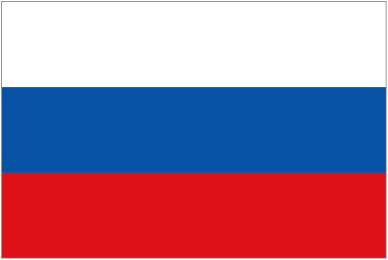

P
L
A
Z
A
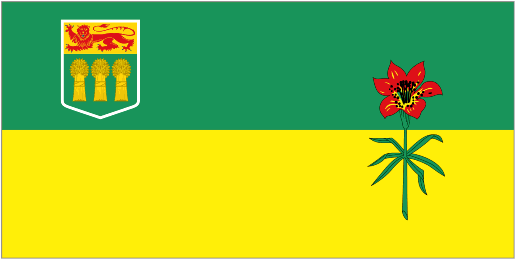
1998 - International Peace Plaza, Rotary Park, Saskatoon, Saskatchewan (Canada). Entry #1372 in the "Peace Movement Directory" by James Richard Bennett (2001).
Yukon (Territory)

P
A
R
K
1979 - Kluane-Wrangell-St. Elias-Glacier Bay-Tatshenshini-Alsek. This is a "transfrontalier park system" located at the borders of Yukon Territory (Canada), Alaska (USA) & British Columbia (Canada). It is declared a UNESCO World Heritage Site for the spectacular glacier and icefield landscapes as well as for the importance of grizzly bears, caribou and Dall sheep habitat. The total area of the site is over 32,000,000 acres (130,000 km²). Entry #1212 in the "Peace Movement Directory" by James Richard Bennett (2001).



P
A
R
K
Date? - Rotary Peace Park, Downtown on Yukon River, Whitehorse, Yukon Territory (Canada).









